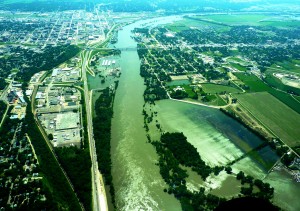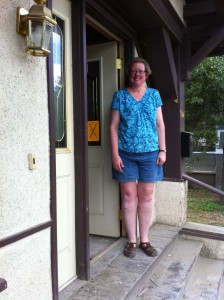
Missouri River flooding in Sioux City: Photo Credit FEMA
Dear Sisters and Brothers:
I am Kevin Massey, Program Director for Lutheran Disaster Response. I’m in Minot North Dakota this week connecting with these flood affected communities and people that I met last month when I was here. Volunteer operations are underway to help clean up and plan for repair and rebuilding a little down the road. Information about how you can help is below.
But first, I began my travels last week visiting communities along the Missouri River. The ELCA Western Iowa Synod organized workshops at St. John Lutheran Church in Council Bluffs Iowa and at Augustana Lutheran Church in Sioux City Iowa. We gathered Lutheran, Methodist, Presbyterian, and Assembly of God pastors from Iowa, Nebraska, and South Dakota serving in communities that have lived all spring and summer under the threat of flooding.
When I was driving from Council Bluffs Iowa to Sioux City Iowa, I had to follow a detour to avoid a portion of Interstate 29 that is closed due to flooding. I remembered how nearly six months ago I stood on an overpass of this same Interstate 29 north of Fargo and saw it underwater. So many communities have spent months and months enduring flooding that seems endless.
From the Missouri River Valley I flew to Minot North Dakota. When I was in Minot a month ago the water was still up and we hadn’t been able to assess yet the damages to so many homes, churches, and business. The water is down now, and the results of catastrophic and heart breaking. Thousands of people remain displaced. Thousands of homes are ruined, some beyond repair.
I delivered cleaning supplies to a volunteer group working on gutting out a flooded home in Minot. This home is across the corner from Christ Lutheran Church. I met three wonderful Lutheran volunteers working at this home. Dennis and Diane Wiesenborn, members of St. John Lutheran Church in Fargo and Vic Voth, a member of Concordia Lutheran Church in Red Wing Minnesota were working on gutting out the home of a Minot couple in their eighties.

Pictured left to right: Diane Wiesenborn, Vic Voth, and Dennis Wiesenborn.
These wonderful volunteers are what this ministry is all about. Lutherans from around the country give so much to love and serve their neighbors.
Later I visited the flooded home of Pastor Heather Brown and her husband David Iversen in Minot. Pastor Brown serves the Trinity Lutheran Parish of Glenburn and Lansford North Dakota north of Minot. Pastor Brown’s home was flooded two feet over the first story. Heather described the generosity and hard work of parishioners of her parish who pitched in and accomplished the necessary gutting of the home. Pastor Brown and her husband are arranging to live in a FEMA trailer on the property of one of the parishioners until repairs to their home can be accomplished. Heather shared, “We could not have made it through this without our wonderful parishioners!”

Pastor Heather Brown at her flooded home in Minot
I admired Pastor Brown for her courage and optimism in the face of her loss. She described that so many people lost more and have harder rebuilding ahead of them. She brings a sense of hope that even though many face hard work, they are not alone.
Please pray for the people of all the areas of North Dakota that have been affected by this catastrophic flooding. Many worry about being forgotten and we can remember them continuously in our prayers. We pray also for those affected by many other disasters, such as tornados across the country in places like Joplin Missouri and Cullman Alabama.
While volunteer operations in many parts of the country are still unfolding, Lutheran Disaster Response in North Dakota is ready to host volunteer groups from the region and outside the region to help in clean up in Minot and other communities affected by flooding. Please share this opportunity with your local Lutheran congregations and organizations.
To register call: 218-443-4970 . You can also go to
www.lssnd.org and complete the Clean-up Volunteer Form and fax it to 701-298-7763 . Volunteers are asked to get an updated tetanus shot and are required to wear long pants and thick soled boots or shoes on site.
Information about housing for groups is available when you call to register. Available housing is austere and volunteers are also invited to camp in tents while volunteering. Tools that would be helpful, but not required to bring include:
- Rubber boots/rubber gloves
- Work gloves
- Goggles or safety glasses
- N-95 masks or any mask that has two straps on it
- Hammers
- Brooms
- Large buckets
- Pliers
- Wonderbars or crowbars.
People across the country responding to these floods also need
financial support to clean up and rebuild. Consider giving a gift to help these neighbors in need. Thank you for your prayers and your partnership in this ministry.
In Christ,
Rev. Kevin A. Massey
Program Director




